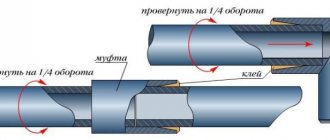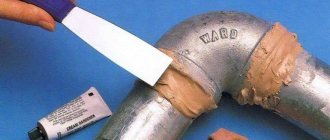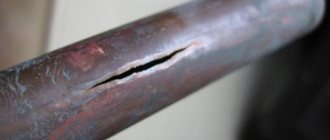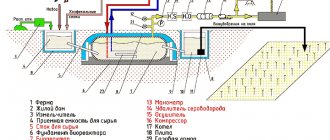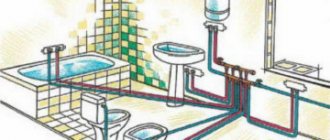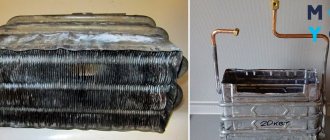Fistula. What is it? This term refers to the deformation on the pipe in the form of a hole. The main reason for its appearance is considered to be chiseled corrosion. This is a clear sign that the plumbing structure is worn out and needs to be replaced. However, not always a person can immediately carry out a full range of work to replace the system with a new one. In this case, it is required to perform partial repairs to eliminate the fistula. It is worth remembering that such repairs are temporary, they do not eliminate the need to replace worn-out pipes. To carry out the work, you can call the wizard, but you can do them yourself.
Tools and materials
In order to eliminate the fistula, you need to stock up on the following tools and materials:
- Drill;
- Bolt set;
- Special adhesive composition BV-2;
- Metal brush;
- Epoxy adhesive;
- Petrol;
- Tap;
- Acetone;
- Kern;
- Putty knife.
Before removing the fistula, it is necessary to drain the water from the system. For this purpose, it is required to close the stop valve. Then all the taps open.
How to seal a hole with an adhesive bandage
To begin with, the pipe is cleaned with a metal brush. Then it is processed with acetone or gasoline. The wait is about 15 minutes. At this time, you can start cutting fiberglass into equal parts. The optimal dimensions of such belts are in direct proportion to the size of the pipes. The tape is cut correctly if it is possible to wrap the structure with it at least six times. The width of the segment should be three times the diameter of the structure. BV-2 adhesive is applied to the edges of the fiberglass segments. Then, on one of the sides of the segment, an epoxy adhesive is spread using a spatula. It should saturate the cut well. For this, during the application of the glue, the spatula must be well pressed against the surface of the tape. Then it is wrapped around the structure. The middle of the segment should fall on the area where the fistula formed. The bandage is pulled together by means of a metal tape. The structure is left for a day. If it is located in a cold room, it will take at least 4 days to wait until the system is operational.
We eliminate the defect by "cold welding"
The defect should be expanded with a drill. Then the structure is cleaned of contamination, treated with acetone. Wait until the structure is dry, and then apply the "cold welding" compound to it. It dries up within ten minutes.
Caution: Wear rubber gloves if you use cold weld or epoxy for repair work. The glue should not come into contact with the skin. If it does get on the skin, it should be immediately removed with cotton wool soaked in acetone, and then the area where the glue turned out to be washed well with warm water and soap.
In conclusion, we can say that the listed methods, which make it possible to seal the hole in the pipes, give only a temporary result. We recommend that you replace the water supply with a new one. People who do not allow the structure to wear out do not even know that this is a fistula.
The term "pipe fistula" - denotes deformation changes in the form of a through hole in the pipeline. The main reason for the formation of this phenomenon on pipe-rolling is considered to be pitting corrosion.
It is a clear signal that the pipeline needs urgent replacement.It is not always possible to perform a full range of pipe repairs with replacement, therefore, it is performed only partially.
At the same time, we must not forget that such events are temporary, and the replacement of areas that have become unusable cannot be avoided anyway. You can use the help of professional craftsmen, or you can repair everything with your own hands.
For embedding, you need to prepare the following tools:
- Drill.
- Bolts (set).
- Brush for cleaning metal products.
- Bonding agent BV-2, and epoxy bonding type.
- Acetone and Gasoline.
- Ketn.
- Putty knife.
Before closing the fistula in the pipe, water is drained from the network. To do this, you need to close the stop valve and open each valve. The system must be free of residual water.
After that, the cleaned area must be degreased with acetone. For the same purpose, you can use gasoline. When sealing, this step is very important.
When applying a bandage to a workpiece with an uneven surface, it is impossible to obtain the most tight joint, and all the sealing measures will have to be repeated anew.
On a well-cleaned surface of the product, the amount of deformation can be accurately determined. And, guided by the information received, they determine the way to further eliminate the deficiency. Fistulas by the form of education are divided into: point
and
elongated
... Eliminate each of them in different ways.
Method three: elimination of the fistula with an adhesive bandage
In this case, the work process consists of several stages.
First step. Clean the surface of the riser from dirt using a metal brush. Then treat it with gasoline. Allow the pipe to dry after processing. This will take fifteen minutes.
Second phase. Take fiberglass and cut into strips. The size of the segments should be such that one strip can wrap the pipe six times. And the width of the tape should be one third larger than the diameter of the installed pipe.
Stage three. Treat the edge of the resulting strip with BF-2 glue. Then apply epoxy glue to one side with a spatula. The glue should completely saturate the material.
Fourth stage. After that, a tape is wound around the water pipe, the central part of which should completely cover the place of damage.
Fifth stage. The resulting bandage must be pulled together and secured with a strip of metal tape.
It is important to remember that you can use the pipe after repair in one day if it is located in a warm room. If the temperature in the room does not exceed seventeen degrees Celsius, then the riser can be operated only after four days.
In what ways is the work carried out
Repair of fistulas on pipes is carried out by the following methods:
- Bolt use
... In this way, they act when it is necessary to close a small hole. The hole is widened with a drill, and a thread is cut in the prepared hole. A prepared screw or self-tapping screw is screwed into it. It is not recommended to do this in old highways. The old age of used metal can lead to the appearance of a more voluminous hole in the "problem" place. - Rubber bandage
... This method is universal, because it is suitable for all pipe rolling stock and any type of water leak. The bandage is selected depending on the size of the leak. It is advised to put a rubber gasket, and a strip is cut out of it 0.5 cm larger than the bandage, and a centimeter smaller than the circumference of the nozzle. It is installed under it and the structure is placed on the fistula zone. If it is not very large, then during the repair it is allowed not to interrupt the water supply. - Repair with adhesive bandage
... First, you need to prepare a strip of fiberglass, or an ordinary bandage. The size of the tape should be enough to wrap the product six times. This tape is soaked with epoxy glue and wrapped so that the flow is located in the center.At the end, the bandage must be secured with a clamp. This pipe network will be able to function only a day after the repair. - Cold weld sealing
... This option is temporary. It targets small holes. After it, it is better to repair the problem area in one of the more reliable ways. The described method is not long-term due to the fact that the effect of water and high temperature on liquid welding leads to its weakening. For repairs with cold welding, you just need to apply it to the appeared area of water leakage on the product.
Video
What to do
If the trickle is small, the leak can be eliminated by plugging the hole, having previously turned off the water supply. After draining the system, it is easier to determine the size of the hole. To do this, clean up the leak with sandpaper, removing a layer of paint and rust.
Before proceeding with the elimination of the problem, it is necessary to degrease the surface with acetone or gasoline.
Note! Cleaning and degreasing is an important stage in the repair, if you neglect this and try to close the hole on an untreated uneven surface, it is difficult to achieve maximum tightness, and after a while the problem will again make itself felt.
By cleaning and degreasing the surface, you can evaluate the nature of the hole and its size, and choose the most correct repair method.
Options for eliminating a fistula in a metal pipe
| Way | Description | Features of the |
| Rubber pads | A strip of rubber under a length greater than the pipe diameter by 50 mm and less than the clamp circumference by about 100 mm is wrapped around the pipe in the place of damage. The bandage is tightly fixed with a clamp. | A universal method that is suitable for repairing leaks of various types on pipelines for various purposes. If the hole is small, you don't even need to interrupt the water supply. |
| Adhesive bandage | A medical bandage or glass cloth, soaked in an adhesive solution, is wrapped in a cocoon in the form of a cocoon at the point of leakage around the pipe six times, covered with a layer of epoxy glue on top, and secured with a clamp. | The water supply can be turned on again only a day after it has completely dried. A cement mortar can be used instead of glue. |
| With a bolt | Expand the hole with a drill, cut a thread in it, then screw in a self-tapping screw or screw. | Suitable for repairing minor damage. It is not recommended for use on old pipes, where such actions can further damage the pipe. |
| Cold welding | Apply the product to the damaged area. | It is considered a temporary measure, after which another better and more reliable method of repairing fistulas should be applied. It should be remembered that cold welding is quickly destroyed by hot water and high temperatures. |
| Bandage and table salt | Small defects at the joints can be eliminated with a bandage sprinkled with salt, which, when dissolved in water, closes microcracks. | Not suitable for large holes. |
Options for eliminating leaks in plastic pipes
Fistulas on plastic pipes can be removed by welding or by means of a threaded method.
Sometimes it happens that in the hot water pipes
that have worked for a short service life (a year and a half, sometimes less), microscopic holes are already formed, the so-called. "Fistulas" through which water begins to flow out under pressure. What could be the reason? Fistula formation can be influenced by two factors.
At first
, an important role is played by the quality of the pipe itself, whether it is made in accordance with GOST (in our case, according to), here, the main thing is chemical. composition of steel with inclusions of harmful impurities and compliance with the pipe wall thickness. On the inner surface of defective pipes, sometimes there are mushroom-shaped influxes of metal, which, with the pressure of water, can break off and form depressions and holes.
Secondly
, the effect is exerted by internal corrosion, protection from which initially needs to be paid close attention, becausehot water DHW is a weak but aggressive medium. According to clause 13.1. , when choosing methods of protecting pipes, it is necessary to take into account the main parameters of the network water, such as: water hardness, pH, the content of sulfates and chlorides, organic impurities, oxygen and free carbonic acid in the water.
13.1 When choosing a method to protect steel pipes of heating networks from internal corrosion and make-up water treatment schemes, the following main parameters of network water should be taken into account: water hardness; pH value; oxygen and free carbonic acid content in water; sulfate and chloride content; the content of organic impurities in the water (water oxidizability).
This should be taken into account, when operating heating networks, to protect pipes from internal corrosion, in accordance with clause 13.2. ... It can be done by increasing the pH (within the recommendations of the PTE), reducing the oxygen content in the network water, coating the inner surface of steel pipes with anti-corrosion compounds or using corrosion-resistant steels, using a reagent-free electrochemical method of water treatment, using water treatment and deaeration of make-up water, using corrosion inhibitors ...
13.2 Protection of pipes from internal corrosion should be performed by: increasing the pH, within the recommendations of the PTE; reducing the oxygen content in the network water; coating the inner surface of steel pipes with anti-corrosion compounds or the use of corrosion-resistant steels; application of a non-reagent electrochemical method of water treatment; application of water treatment and deaeration of make-up water; the use of corrosion inhibitors.
With increased corrosion, fistulas will form, first of all, in places where there is a local decrease in the thickness of the wall or depression, and in places with inhomogeneous chemical. composition. To control internal corrosion, in accordance with clause 13.3 ,. provision should be made for the installation of corrosion indicators.
13.3 To control internal corrosion on the supply and return pipelines of water heating networks, at the outputs from the heat source, and, in the most characteristic places, it is necessary to provide for the installation of corrosion indicators.
It should be noted that, although rarely, stray currents that somehow pass through the pipe can lead to an increased degree of corrosion.
The term "pipe fistula" - denotes deformation changes in the form of a through hole in the pipeline. The main reason for the formation of this phenomenon on pipe-rolling is considered to be pitting corrosion.
It is a clear signal that the pipeline needs urgent replacement. It is not always possible to perform a full range of pipe repairs with replacement, therefore, it is performed only partially.
At the same time, we must not forget that such events are temporary, and the replacement of areas that have become unusable cannot be avoided anyway. You can use the help of professional craftsmen, or you can repair everything with your own hands.
Troubleshooting Plastic Products
A fistula on a plastic pipe is sealed in two ways: threaded
and
soldering
.
The threading method can only be used for products where threading is possible. A piece of pipe that has become unusable with a fistula is cut off with special scissors.
An insert is prepared from blanks of the required volume. On plastic materials, the thread is cut with a stick. Then, with fittings and couplings, another structure is attached to the pipe network.
Welding on plastic pipe materials begins with cutting off the flowing section. After that, a fitting and a workpiece of the appropriate size are prepared.
A heated plastic pipe soldering iron is used to heat the outer edges of the plastic and the inner edges of the fittings. At the final stage of the repair, the prepared pipe is connected with fittings.
This should be done without delay, since plastic tends to instantly solidify, and it is not possible to remake an incorrectly fastened structure a second time.
Repair of copper products
A copper pipe fistula is not uncommon. Copper pipes have been used in construction for a very long time. They are not only suitable for all types of highways, but also have high ductility and resistance to corrosion.
Video
Their service life is not limited, and with ease they will stand the entire period allotted to the house without breakdowns. But, sooner or later, situations arise when these products need to be repaired from the fistula.
For which you need the participation of a specialist. In order not to face the fact of a large fistula, the network should be checked regularly. At the slightest notice of damage, you should immediately take up the elimination.
Malfunctions in the heating line
Communications do not last forever, and even with the use of high-quality materials, a fistula may form on the heating pipe.
The following reasons become the basis for a heating leak:
- Wear. It is associated with a long period of use of the heating system. Most often, steel products suffer from leaks.
- Violation of the operating conditions of the heating system. This includes surges in temperature and pressure, water hammer.
- Use of goods of questionable quality.
- Poor tightness of the joints.
If a leak appears on the heating pipes, proceed as follows.
Video
It is necessary to prepare several clamps with rubber seals (in this case, the most important thing is not to forget to turn off the water, stop the operation of the heating boiler, disconnect the pumps from the power supply and close the necessary valves and taps
). Repair of pipe-rolling assortment in the heating network depends on their type.
For example, steel pipes with a problem of a joint of a threaded variety will require disassembling the joint, and applying a new layer of winding.
If the destruction has formed on the heating pipe itself, then the problem area will have to be welded using gas or electric welding.
If a copper pipe is leaking, then it must also be welded. But, welding work with copper is rather complicated, therefore, it is better to entrust them to specialists.
If the metal-plastic pipelines of the heating system are leaking, then it will be necessary to replace the entire section where the leak has formed. In this type of pipe rolling, it is most often formed in compressor-type joints.
On plastic heating pipelines, the problem is solved in this way. This is a replacement for an entire site. Soldering of polypropylene is advised to be carried out in accordance with all the norms of this work. Any errors can provoke the fact that the joint collapses after a very short time.
Video
IMPORTANT!
When working with plastic products, it is forbidden to make changes to the wiring diagram.
Features of metal pipelines
If we are talking about how to weld a fistula in a pipe, which is large in size, then there is only one recommended way out - a complete replacement.
And, if the fistula is small, then here are some options for action. But, these recommendations can only be applied when the metal assortment pipes are leaking.
Video
Option 1
... In this case, the defect is eliminated with a medical bandage and cement for sealing. First, a solution of cement and water is diluted. 15-20 strips are cut from the bandage, 20 cm long. The strips are moistened in the solution and wrapped around the main line. The result is something that looks like a cocoon. A cement solution is applied on top of it. All this should dry for 24 hours, and then the pipe network can be started up.
Option 2.
Pieces of rubber to make repairs. A strip is cut out of the rubber, slightly longer than the circumference of the pipe. The problem area is tightly fitted with this strip, which is then fixed.For reliability, it must be covered with a cement bandage, as described in the previous method.
Option 3
... Bandage and table salt. So small "gaps" between the joints are covered. For this, the place of leak is wrapped with a bandage mixed with salt. Dissolving salt fixes microleakage. But this method cannot be applied to large formations; one should act differently.
Defects in water supply networks
How to close a fistula in a water pipe, people are often interested. Unfortunately, plumbing leaks are very common.
To seal the place of water flow in this case, you can use such devices as a clamp, cold welding or any other folk methods.
The condition of the plumbing system must be checked constantly. If the workpieces have served for a long time, and it is not possible to replace them quickly, then it is necessary to prepare several clamps for a stock in order to make repairs, because water leakage in such products can form at any time.
Video
If streaks of rust appear on the water supply system and paint swells in places on the pipes, then this serves as a signal of the imminent appearance of pitting corrosion.
IMPORTANT!
A fistula in a cold water pipe under a layer of paint is not as dangerous as in an analogue with hot water. If the water from under the removed paint during the repair from the pipe breaks through with a fountain, it can cause serious burns to a person.
Leaking sewer lines
Considering the question of how to eliminate a fistula in a sewer pipe, it should be noted that to cope with this task a little harder
than to repair water leaks at the joints.
An assessment of the defect and strength of the workpiece will be required at the beginning of the embedding. Small leaks can be eliminated by means of plugs for this type of tube rolling. You can also try the repair method - wrapping with gauze soaked in epoxy resin.
The option with a rubber gasket secured with a clamp will help to temporarily seal the water leak. It and a repair clamp can be purchased at any building materials store. Also, its gasket can be fixed using a wire.
Longitudinal cracks and chips on the branch pipe can be easily repaired with a sealant. To do this, the fistula is slightly enlarged, degreased and dried.
After that, a sealant is applied to the site. Metallic materials in the sewage system from water leaks are sealed with cold welding.
Do-it-yourself leak repair
Water leaks occur at any time, so sealing fistulas in pipes with your own hands is a very important skill.
For very urgent closure of the fistula, a clamp is recommended. It is a metal tie. And you need to apply a clamp in this way:
- The water supply system is blocked.
- The bolts on the clamp are loosened and wrapped around the water leakage area.
- The nuts on the clamp are tightened with an adjustable wrench, while the pipe itself is adhered to with a pipe wrench. Without support, which will entail additional water leaks and repair costs.
Video
Termination methods with the use of a locknut and with the help of a rubber band are also effective. In general, it is not difficult to close up and eliminate a fistula on a pipe.
If you are not confident in your abilities, then it is worth inviting professional masters. And if the filling of the fistula was carried out in one of the temporary ways, then it is worth worrying about how to complete a full pipe repair in the near future.
This article will consider how the fistula that appears on the pipe is closed, what methods of termination exist, and detailed instructions for termination are given.
The situation with the appearance of a fistula in a metal riser for heating or water supply occurs quite often, especially in the case of a riser for hot water supply.
The first sign that a fistula has appeared in the pipe and it can "jerk" is the appearance on it in some cases of a red build-up, which is scientifically called pitting corrosion, and among the people - "a pipe in a pipe".
Fistulas appear in pipes both as a result of wear and tear and under the influence of stray currents, but at the moment of appearance of a fistula, the cause fades into the background, and it is much more important to find out how to fix the situation.
How to close a fistula in a pipe: a guide to action
In this publication, it will be considered how the fistula that appeared on the pipe is closed, what methods of sealing are there, and detailed instructions for sealing are given.
The situation with the occurrence of a fistula in an iron riser of heat supply or water supply appears very often, especially in the case of a riser of hot water supply.
The first sign that a fistula has arisen in the pipe and it can "jerk" is considered the appearance on it in many cases of a red build-up, which is scientifically called pitting corrosion, and among the people - "a pipe in a pipe".
Fistulas appear in pipes both as a result of wear and tear and under the influence of stray currents, however, at the moment of fistula onset, the cause fades into the background, and it is much more important to find out how to correct the situation.
Fistula sealing methods

Sign of a fistula
The fistula that appears in the pipe can be sealed in several ways, any of them asks for preliminary water drainage from the system by closing the stop valve and opening all taps. Let's consider the main ways to seal fistulas in more detail.
Sealing with a bolt
It includes the following stages:
The main thing: this method is not suitable in the case of outdated pipes, since it is usually impossible to cut pipe threads on them, attempts to cut in most cases lead to an increase in the diameter of the leak.
Sealing with a temporary bandage
This method is used in most cases when the pipe fistula has an oblong oblong shape.
A bandage with rubber gaskets is applied to the fistula, and such material as can be used as a gasket:
- Thick rubber glove;
- Old bicycle tire;
- Medical tourniquet;
- The shaft of a rubber boot, etc.
The main thing: a rubber gasket must have a size much larger than the size of the fistula.
The gasket is attached to the pipe using specialized clamps or bolts.
Sealing with adhesive bandage
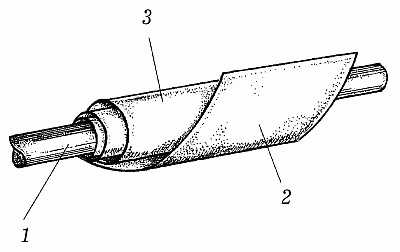

Sealing with adhesive bandage: 1 - pipe with a fistula, 2 and 3 - tape
Using an adhesive bandage, the fistula on the pipe is closed as follows:
- They clean the pipe from dirt with a metal brush, treat its surface with gasoline or acetone and allow it to dry for at least 15 minutes.
- The fiberglass is cut into strips, the dimensions of which depend on the pipe diameter in such a way that the length of the tape allows making at least 6 layers of winding, and its width exceeds the pipe size by at least a third.
- The edges of the tape are treated with BF-2 glue, then on one side of the tape, using a spatula, they are covered with epoxy glue.
- Press the spatula well so that the tape is saturated with glue.
- Then the tape is tightly wound on the finished and cleaned surface of the water supply pipe so that the center of the tape covers the damaged area.
- The bandage is pulled together with a metal tape.
- After a day, you can use the repaired pipe.
The main thing: in the case of a pipe located in an unheated room with an air temperature not exceeding 17 °, it is necessary to start using the pipe only after 4 days.
Repair by "cold welding" method
For temporary sealing of the appeared fistula, you can also use a specialized compound called "cold welding":
- The fistula is enlarged with a drill.
- The pipe surface is cleaned and degreased with acetone.
- After the pipe has dried, the composition is applied to it and wait for its complete hardening for 10 minutes.
The main thing: to do work with epoxy glue and "cold welding" should be done with rubber gloves.
In case of penetration of glue or composition onto the skin cover, it must be wiped off with cotton wool soaked with acetone, then thoroughly wash your hands with soap and warm water.
Fistula sealing instructions
In the case when the pipe is not new, it is recommended to purchase several clamps in advance, their diameter converges with the water supply riser, and also cut the rubber under the clamps.
This preparation may be necessary if the fistula appears at night - and there is a risk of serious flooding while waiting for the locksmith on duty or the emergency team.
In the case of a small fistula, it can be repaired using a conventional car clamp:
- A thin strip is cut from a piece of rubber, the width of which is equal to or 3-4 mm larger than the width of the clamp. The length of the tape is measured by wrapping it around the pipe and cutting off the unnecessary part.
Clamp and tape length
- Then the clamp is opened and put on the pipe.
- Slightly grab the clamp.
- A cut-out rubber gasket is inserted under the clamp and carefully brought to the site of the fistula formation.
- Cover the fistula and tighten the clamp with a wrench or screwdriver, depending on the clamp tightening device.
As a temporary measure, when there is a very small fistula, and there is no clamp nearby, the fistula can be closed by simply breaking off and inserting the tip of a match into it.
The main thing: this method should be used exclusively in an exceptional case - as a result, when the pipes are very old, the fistula may not close, but only increase in diameter.
And even if the fistula is successfully sealed with a match, it should be closed as soon as possible with a clamp.
Clamp for large fistulas
In case of a more serious fistula, it would be nice to have a more solid clamp ready (see photo):
- First of all, they turn off and drain the water from the pipes.
- Before mounting the clamp, inspect the pipe surface. If it is uneven, it is cleaned with sandpaper so that there is no water leakage through the inherent roughness.
- Further, as described, they cut the rubber lining under a more powerful clamp and also install it in the place of the fistula.
Closed large fistula
As can be seen from the publication, self-sealing of fistulas in pipes is not very difficult; this does not require any special skills and tools. For example, if metal risers are installed in the apartment, it would be nice to always have a couple of clamps and rubber gaskets ready for them so that the fistula does not occur unexpectedly.
Fistula sealing methods
The fistula that appears in the pipe can be closed in several ways, each of which requires preliminary draining of water
from the system by closing the stop valve and opening all taps. Let's consider the main methods of sealing fistulas in more detail.
Sealing with a bolt
Includes the following steps:
- The fistula is widened with a drill.
- With a tap.
- A bolt is screwed into the resulting hole.
Important: this method is not suitable for old pipes, since it is almost impossible to cut on them, attempts to cut usually lead to an increase in the diameter of the leak.
Sealing with a temporary bandage
This method is usually used when the pipe fistula has an elongated elongated shape.
A bandage with rubber gaskets is applied to the fistula, and materials such as:
- Thick rubber glove;
- Old bicycle tire;
- Medical tourniquet;
- The shaft of a rubber boot, etc.
Important: the rubber pad should be substantially larger than the fistula.
The gasket is fixed to the pipe using special clamps or bolts.
Sealing with adhesive bandage
Using an adhesive bandage, the fistula on the pipe is closed as follows:
- Clean the pipe from dirt with a metal brush, treat its surface with gasoline or acetone and allow it to dry for at least 15 minutes.
- The fiberglass is cut into strips, the dimensions of which depend on the diameter of the pipe so that the length of the tape allows at least 6 layers of winding, and its width exceeds the pipe diameter by at least a third.
- The edges of the tape are treated with BF-2 glue, after which they are covered with epoxy glue on one side of the tape with a spatula.
- Press the spatula firmly so that the tape is saturated with glue.
- Next, the tape is tightly wound on the treated and cleaned surface so that the center of the tape overlaps the damaged area.
- The bandage is pulled together with a metal tape.
- In a day
a repaired pipe can be used.
Important: in the case of a pipe located in a cold room with an air temperature not exceeding 17 °, the pipe should be used only after 4 days.
Repair by "cold welding" method
To temporarily seal the formed fistula, you can also use a special compound called "cold welding":
- The fistula is expanded with a drill.
- The pipe surface is cleaned and degreased with acetone.
- After drying the pipe, the composition is applied to it and wait for its complete hardening within 10 minutes.
Important: work with epoxy glue and "cold welding" should be done with rubber gloves.
If the glue or composition gets on the skin, wipe it with cotton wool moistened with acetone, and then wash your hands thoroughly with soap and warm water.
Ways to eliminate fistulas in the riser pipe, heated towel rail, gas line and other places
Which method is best to eliminate the fistula in the heating pipe depends on the material from which the water supply is made, the place of leakage (at the junction of the joints or in an open area), the diameter of the perforation. More often they use one of the described methods:
- Sealing the hole using a bolt.
- Applying a temporary rubber bandage.
- Applying fiberglass adhesive patch.
- Elimination of leaks by means of "cold welding".
Sealing a fistula in a pipe with a bolt
Sealing the hole using a bolt. If a small diameter hole is formed in an open section of a metal pipe, then it can be repaired with a bolt, self-tapping screw or screw.
- Remove rust from the edges of the hole.
- Drill the hole with a drill with a metal drill to the size of the bolt to be inserted.
- Thread the drilled hole using a tap.
- Screw in the bolt, using flax and Unipak for sealing.
- Paint the restoration site.
It is important that the dimensions of the inserted bolt or screw do not impede the movement of the fluid. This method is effective if damage has occurred from impact or from poor drilling. The area destroyed by rust is recommended to be repaired by other methods, since the metal thinned by corrosion easily crumbles during drilling. Every man can close a fistula in a pipe.
Caisson bandage
Applying a rubber band. The temporary bandage is presented with a rubber pad, fixed on the damaged surface. In the role of a sealing gasket, rubber products are used larger than the hole: a tourniquet, a splint or a glove. A clamp for a pipe of a suitable size is not difficult to purchase at the "Auto parts" store. The order of work is as follows:
- Clean metal from corrosion residues.
- Wrap the fistula on the pipe with a rubber gasket several times.
- Fit the pipe clamp and tighten.
If necessary, you can use two tightening clamps at opposite ends of the gasket.
Patch in the heating pipe and cast iron radiator
Applying fiberglass adhesive patch. This method is used if the damage is large enough. The bandage is a patch made of fiberglass and epoxy adhesive that dries to a durable surface.Motorists are familiar with this method of repairing damage on metal, who had to put patches on areas damaged by corrosion.
- Shut off the water supply to the repaired area.
- Completely clean the surface to which the bandage will be applied from paint and rust.
- Degrease the cleaned area with a solvent.
- Cut the fiberglass tape twice as wide as the fistula in the pipe and long enough to wrap the pipe several times.
- Saturate the tape liberally with epoxy adhesive.
- Wrap the bandage tightly around the fistula on the heating pipe, being careful not to wrinkle.
- After waiting for drying, clean and paint the surface.
Cold welding of a pipe under pressure
Elimination of leaks by means of "cold welding". The special adhesive hardening compound is called "cold welding" for the strength of the joint formed. They can seal a fistula in a hot or cold water pipe. You can purchase it from auto parts departments or hardware stores. Cold welding is applied as follows:
- Remove rust from metal and paint around the hole 10-15 mm.
- Treat the surface with a degreasing agent - solvent or acetone.
- Close the fistula by applying “cold welding” on it with a thickness of 2-3 mm, evenly distributing it over the surface. Wait for hardening.
- File and paint the surface.
Advice. There are several types of "cold welding". For water supply, it is advisable to choose one that is intended for application on a wet surface.
Sealing a fistula at home is quite possible with your own hands
Fistula sealing instructions
Such preparation can be useful if a fistula occurs at night - and there is a risk of serious flooding while waiting for the locksmith on duty or the emergency team.
In case of a small fistula, it can be repaired with a standard car clamp:
- A thin tape is cut from a piece of rubber, the width of which is equal to or 3-4 mm more than the width of the clamp. The length of the tape is measured by wrapping around the pipe and cutting off the excess.
- Next, the clamp is opened and put on the pipe.
- Slightly grab the clamp.
- A cut out rubber gasket is inserted under the clamp and carefully brought to the site of the fistula formation.
- Cover the fistula and tighten the clamp with a wrench or screwdriver, depending on the clamp tightening device.
As a temporary measure, when there is a very small fistula, and there is no clamp at hand, the fistula can be closed by simply breaking off and inserting the tip of a match into it.
Important: this method should be used only as a last resort - as a result, when the pipes are very old, the fistula may not close, but only increase in diameter.
And even in the case of successful sealing of the fistula with a match, it should be closed as soon as possible with the help of a clamp.
In case of a more serious fistula, it is advisable to also have a more solid clamp ready (see photo):
- The first step is to turn off and drain the water from the pipes.
- Before installing the clamp, inspect the pipe surface. If it is uneven, it is smoothed with sandpaper to prevent water from flowing through the existing roughness.
- Next, as described, cut out a rubber lining under a more powerful clamp and also install it in the place of the fistula.
As you can see from the article, self-sealing of fistulas in pipes is not particularly difficult; this does not require any special skills and tools. In the event that metal risers are installed in the apartment, it is advisable to always have a couple of clamps and rubber gaskets ready for them so that the appearance of a fistula does not catch by surprise.
The most common cause of holes in steel pipelines is pitting corrosion. As a rule, the appearance of fistulas indicates the deterioration of the water supply system. To avoid serious accidents, it is recommended to completely replace the water pipes.If, for some reason, replacing the pipes is not possible, you can carry out temporary repairs with your own hands.
In order to close the fistula in the pipe, you will need:
- drill or core,- tap,- bolts,- glue BF-2,- metal brush,- gasoline or acetone,- putty knife,- epoxy adhesive
Drain the system before starting work. To do this, close the stop valve and then open all the taps.
Bolt repair
Expand the fistula with a drill, tap the thread. Then screw the bolt into the hole. Please note that this repair method is not suitable for old pipes. Most likely, it will not be possible to cut a full thread on the old pipe and the size of the leak will only increase.
Repair with a temporary bandage
This type of fistula repair is usually used if the fistula has an elongated oblong shape. Apply a bandage with rubber seals. A thick rubber glove, an old bicycle tire, a rubber boot flap, or a medical tourniquet can be used as a spacer. The size of the rubber pad should be much larger than the size of the fistula. Fix the gasket to the pipe using bolts or special clamps.
Repair with adhesive bandage
Clean the pipe from dirt with a wire brush. Treat the pipe surface with acetone or gasoline. Let dry for 15 minutes (minimum). ? Cut the fiberglass into tapes. Their dimensions are determined based on the diameter of the pipes. The length of the tape should be at least six layers of winding. And the width should exceed the pipe diameter by more than a third.? Treat the edges of the tape with BF-2 glue. Spread epoxy adhesive on one side of the tape with a trowel. Saturate the tape with epoxy glue while pressing down firmly with a putty knife. Wrap the tape tightly over the cleaned and finished pipe surface, so that the middle of the tape is over the damaged area. Pull off the bandage with metal tape. You can use a pipe repaired by this method no earlier than in a day. And if the pipe is in a cold room (air temperature 17 degrees and below), then no earlier than four days later.
Repair by "cold welding" method
You can also temporarily repair the formed fistula using a special compound known as "cold welding". Expand the fistula with a drill. Clean the pipe surface and degrease it with acetone. Dry the pipe and apply the compound to it. The time for complete hardening of the composition is 10 minutes.
Rubber gloves should be worn when working with “cold welding” and epoxy glue.
Try to keep the epoxy out of your skin. If this happens, wipe the skin with cotton wool soaked in acetone to remove the glue. Then wash thoroughly with warm water and soap.
If possible, it is worth replacing the steel water supply system with a more modern and perfect one.
The article below will help you independently resolve the issue of sealing fistulas on pipes. The problem of how to seal a fistula in a pipe under pressure is really very urgent.
After all, a leak in the pipes of the water supply, heating, drainage can occur at the most inopportune moment, and it must be solved quickly and efficiently.
First of all, you need to understand that all the proposed tips are interesting, but, unfortunately, they are not long-term, and the results in the future can be much more deplorable
.
They are not only inexpensive, but also easy to install. Their installation is not complicated, and it is easy to carry out it yourself.
When talking about methods of sealing leaks, a "breakthrough" of a small scale is implied. If the water breaks through with a fountain, then there is only one way out - replacing the pipeline.
Fistula is called pitting corrosion
, which is formed from partial destruction of the material, or from general old age. The result is a hole through which fluid flows outward.
The external visual manifestation of the fistula is swollen paint and rust build-ups. Seeing such a build-up, one should not rush to rip it off, because the size of the damage under it is not predictable.
In general, patching up pitting is not a difficult job, but nevertheless, you also need to seriously prepare for it.
For such events, you will need (experts say that you must always have it at hand):
- Clamp (a couple of pieces).
- Rubber pads (they can be easily made from any materials at hand, such as old boots, thick rubber gloves, bicycle tires, and so on).
- Screwdriver and bolts.
- Epoxy materials.
- Degreasing liquid.
- Emery.
- Cold welding.
The reasons for the appearance of fistulas on a water pipe are most often reduced to one denominator. This impact corrosion
.
The most suitable temperature indicator for corrosive formations is +15 degrees. Most often, pipe-rolling materials in this mode are in the spring, summer and autumn periods.
It also accelerates corrosion damage and water located in the system. Over time, inside metal pipelines, rust builds up.
The metal in such products is becoming more and more thinner every year. And then the moment comes when corrosion breaks through the wall completely. The result is a leak.
When a small fistula occurs, water slowly flows down the pipeline, where a puddle is subsequently formed.
It is necessary to eliminate this problem immediately, without waiting until it turns into a big nuisance. If the leak is small, then it can be repaired under pressure without shutting off the water supply.
Hole sealing process
When the system is worn out, it is advisable to prepare several clamps that have the same diameter as the pipeline. In addition, you need to stock up on rubber for them. In the event that a water pipe fistula appears at night, such preparation will not be superfluous, since the emergency team is unlikely to arrive in a matter of minutes.
If the hole is small, it can be closed using a conventional vehicle clamp:
- A thin tape is cut from a piece of rubber - its width should be 2-4 millimeters larger than the same parameter for the clamp. The length of the cut is measured by wrapping the material around the pipe. The excess piece of tape is cut off.
- The clamp is opened and placed on the pipe, then it is not tightly gripped.
- A rubber gasket is placed under the clamp and gently pushed to the place where the hole appears.
- After covering the fistula, the clamp is tightened with a screwdriver or key, depending on the characteristics of the device of the tightening product.
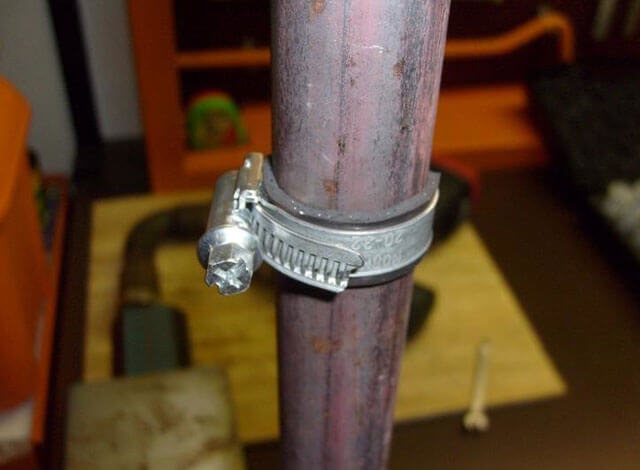

If a very small fistula is found and there is no clamp at hand, the hole can be closed with the end of a match. But this method is rarely used, since it is rarely possible to eliminate the leak in old pipelines - it only increases in size. Even if the gap is successfully sealed with a match, it must be repaired as soon as possible with a clamp.
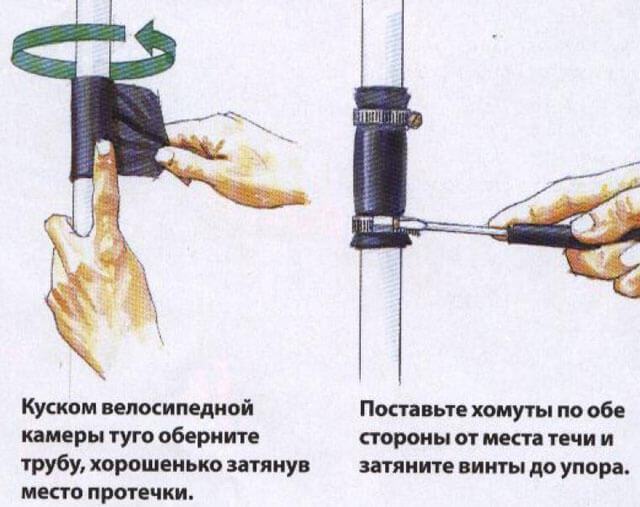

To eliminate a serious fistula on the hot water pipe, you will need a more powerful clamp:
- First of all, they turn off the water and drain it from the pipeline.
- Before installing the clamp, carefully inspect the pipe. When its surface is uneven, it should be sanded to prevent fluid from flowing through the roughness.
- A rubber pad is cut out under the clamp and placed on the hole.
From the above information, it is clear that it is quite possible to eliminate the fistula in the pipe with your own hands - no special tools or special skills are required. If you have metal risers, you need to prepare several clamps and rubber gaskets.
Any leak in a pipe is an emergency that must be quickly neutralized regardless of the type of mains used (water supply, heating, etc.). To eliminate leaks in pressurized water pipes at home, it is important to be extremely careful.Especially when it comes to hot water supply. Burns and large flooding are not excluded here. It should be remembered that latka is not a panacea. If there is a hole in the tube, the same fate awaits the highway in its other sections. It is best to change the metal piping to plastic (PP, PVC) as soon as possible. In addition, it is possible to close fistulas on a hot or cold water pipe only when the hole is small. If the liquid gushes like a fountain, no clamps and patches will help.
Leaks in various systems
A fistula in a hot water pipe or any other system that consists of metal pipes can be quickly repaired in the following ways:
Option 1.
Medical bandage and cement mortar. It is cut into pieces, soaked in a previously prepared cement mortar. These bandages are wound around the leakage zone, forming a structure similar to a cocoon.
Finally, the resulting structure is also covered with a cement mortar. It dries up in about one day.
Option 2.
Pieces of rubber. The rubber is cut into strips. Each of them should be slightly longer than the circumference of the pipe.
Option 3.
Food salt and bandage. Typically, this method is used to seal leaks under pressure in couplings, elbows, etc. The leaking area is wrapped with a bandage mixed with salt.
When dissolved, the salt fixes the microleakage. If we compare this method of sealing under pressure, then it is immediately worth noting that it is not as reliable as the first two.
Option 4.
Bandage. This method can be used for pipes under pressure. The bandage is one of the oldest and most proven options. A small car clamp can be used for fistula up to 0.005 cm in volume.
For the clamp, a strip of rubber is cut out, a couple of millimeters wider than the clamp itself. The length of the strip should be one centimeter shorter than the circumference of the pipeline. ...
This whole structure is obliged to completely cover the fistula. Then the clamp is tightened. With these measures, the surface at the place of corrosion must be cleaned.
Video: ways how to close a fistula
It should not contain irregularities. If this is not done, then the liquid will pass through the band in the area of uneven areas.
How to close a fistula in a pipe under pressure in a plumbing and heating system
The note below will help to remove the issue of sealing fistulas on pipes on its own. The problem of how to close a fistula in a pipe under pressure is actually very important.
After all, a leak in water pipes, heating, drainage can appear when you do not expect it at all, and it should be solved quickly and effectively.
First of all, it is important to understand that all the proposed recommendations are original, but they are not considered long-term, and the results in the future can be much more "deplorable".
Experts advise that when a leak occurs, immediately change pipe-rolling products to new ones. At the same time, polypropylene pipes can help to make less material costs.
They are not only not cheap, but also common in styling. Their installation is not difficult, and it is easy to carry out on your own.
When it comes to methods of sealing leaks, we mean a "breakthrough" of a small scale. If the water breaks through with a fountain, then there is only one way out - replacing the pipeline.
Fistula is called pitting corrosion, which is formed from partial destruction of the material, or from all old age. The result is a hole through which fluid flows outward.
The external visual identification of the fistula is swollen paint and rust build-ups. Seeing such a build-up, one should not rush to rip it off, because the size of the damage under it is not predictable.
In general, patching up pitting is not hard work, but, nevertheless, you also need to prepare for it strictly.
For these events, you will need (professionals say that you need to always have it nearby):
- Clamp (a couple of pieces).
- Rubber pads (they are very easy to make from any materials that are always at hand, such as old boots, thick rubber gloves, bicycle tires, and so on).
- Screwdriver and bolts.
- Epoxy materials.
- Degreasing liquid.
- Emery.
- Cold welding.
See also - how to close up a leak in the heating water supply system: ways to eliminate
The causes of fistula
The causes of fistulas in a water pipe are very often reduced to one denominator. This is the action of corrosion.
The most optimal temperature indicator for corrosive formations is +15 degrees. Very often, pipe-rolling materials are in this mode in the spring, summer and autumn periods.
It also accelerates corrosion damage and water in the system. With a certain period in the middle of the line of pipes made of metal, rust increases.


The metal in these products is becoming more and more thinner from year to year. And then the moment comes when corrosion breaks through the wall completely. The result is a leak.
When a small fistula appears, water slowly flows through the pipeline, where a puddle is subsequently formed.
You need to remove this problem immediately, without waiting until it turns into a big trouble. If the leak is small, then it can be repaired under pressure without shutting off the water supply.
Leaks in a wide variety of systems
A fistula in a hot water pipe or any other system consisting of pipes made of metal can be quickly repaired in the following ways:
Option 1. Medical bandage and cement mortar. It is cut into pieces, soaked in a cement solution prepared in advance. On the territory of the leak, these bandages are wound, forming a structure similar to a cocoon.
At the end, the resulting structure is also covered with cement mortar. It dries in about 1 day.
Option 2. Pieces of rubber. The rubber is cut into strips. Any of them should be slightly longer than the circumference of the pipe.
Further, the strips are tightly stretched, wrapping the “emergency” area, and fastened with clamps. In this way, you can close a small fistula even on the damaged part of the heating radiator.
Option 3. Salt and bandage. Basically, this option is used to seal leaks under pressure in couplings, elbows, etc. The flowing area is wrapped with a bandage mixed with salt.
When dissolved, the salt fixes the microleakage. If we compare this method of sealing under pressure, then it is immediately noticeable that it is not as good as the first two.
Option 4. Bandage. This option can be used for pipes under pressure. The bandage is one of the oldest and already tested options. A small car clamp can be used for a fistula with a volume of up to 0.005 cm.
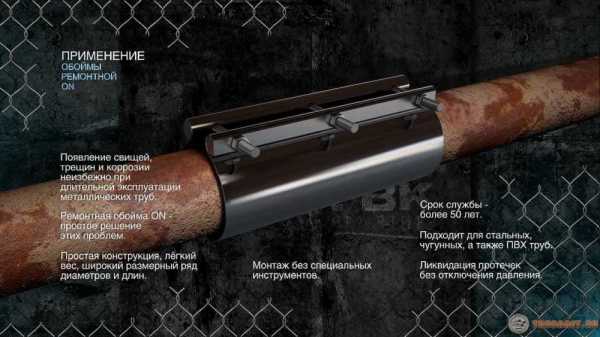

For the clamp, a strip of rubber material is cut out, a couple of millimeters wider than the clamp itself. The length of the strip should be one centimeter shorter than the circumference of the pipeline. The clamp is put on the pipeline, and a rubber gasket is placed under it.
All this design is required to completely close the fistula. Then the clamp is tightened. With these measures, the surface at the place of corrosion must be cleaned.
Video: ways how to close a fistula
It should not contain irregularities. If this is not done, then the liquid will pass through the bandage in the area of uneven areas.
Sealing a fistula in plastic pipelines
How to remove a fistula in a water pipe if it is made of plastic. Pipe-rolling plastic materials are now used quite often.
They quickly replaced conventional steel products due to a wide range of positive parameters. These materials are not only easy to lay, but also easy to repair when fistulas appear.
It is possible to close a leak on a plastic blank by using couplings and connectors (part of the line is changed).At the same time, a new squeegee with a cut thread is prepared.
With the help of elements for connections, it is put in place of the site that has become unusable. If there is no decisiveness that all actions are done correctly, then you can turn to a professional for help.
After inspecting the structure, he will give the correct answer whether it is suitable for work, or recommend a complete replacement of the damaged pipe.
This method can be used not only for plastic pipes, but also for iron ones. Only it will not work to remove the fistula with this method under pressure. We'll have to worry about turning off the water in the water supply system.
In order for the water pressure (find out the ideal values for the water supply system) not to interfere with repairs, you need to close the key valve. It is mainly installed in a toilet.
Video: removing water leaks using available methods
How to brew a fistula in a water pipe
How to brew a fistula in a plastic pipe with water can be learned from the method that is attached below.
Unlike the previous version, which could be used not only for plastic products, this option is only suitable for working with PP pipe-rolling materials.
Actions are carried out using a special tool for soldering plastic - an iron. This tool melts the prepared important parts, and fixes them after it has cooled down.
To close up minor damage to the site, all remedial measures can be carried out under pressure.
However, for a formation that differs in significant dimensions, the water supply system will need to be closed, since it will be impossible to weld the defect under pressure.
Everyone can work with an iron. No specialized experience is required for this. An instruction is attached to these devices, where the general operation process is described step by step.
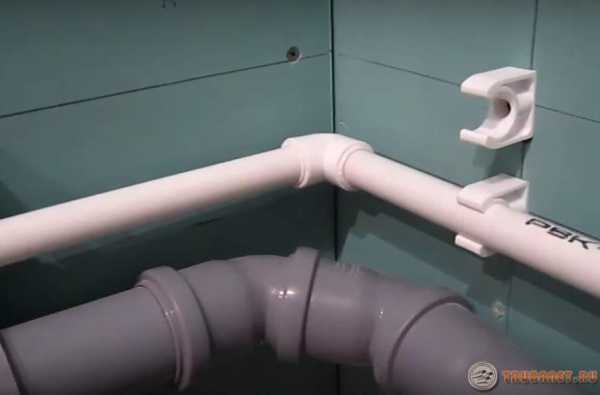

After reading it with great attention, you can safely start repairing the PP pipeline. It is not difficult to brew a leak in this manner.
Hot water supply specifics
Fistula in the hot water pipe occurs more often than in other places. The place that is most prone to this phenomenon is the riser. The initial signs of danger in such a system are rusty build-up.
Video: how to seal a leak on a squeegee
It has already been written above that if a decision is made to close up the leak, then this build-up cannot be torn off. In the case of hot water supply, such actions can lead to serious burns.
It is possible to close such a fistula in the pipeline using a bolt or a temporary bandage. Both in the first and in the other version, it is impossible to act under pressure. The metering unit must be closed before the work can be done.
A small leak can be repaired under pressure using an adhesive bandage. The edges of fiberglass with applied BF-2 glue are applied to the damaged area (the tape is applied very tightly). At the end, the tape must be tightened with a metal tape. Such a section will be able to work under pressure only after 24 hours.
Also in this situation it is possible to seal the leak with "cold welding". It's better not to do such work under pressure. The hole that appears is slightly larger with a drill, and the area is degreased.


When everything is dry, a composition is applied to the leaking crack. It should freeze completely. This takes about ten minutes.
Well fistulas
If we consider the sources of water supply in private areas, then the wells can be called the most promising. Compared to wells, they contain very good quality water. It needs almost no cleaning or additional filtration.
During the working period, the wells, pump and water-lifting lines from the pipes vibrate. This leads to a weakening of the joints on the water lines, and therefore leaks (fistulas) appear. Sometimes it ends up in serious accidents.
The well does not stop working with the vibration of the riser pipe due to the pumping equipment, and this provokes the weakening of the joints.As a result of the formation of a fistula, the functioning of the well can be completely disrupted.
Video
Most owners of private houses try to carry out repairs and remove such leaks on their own, but professionals strongly advise to trust this to specialists.
Such repairs cost a lot of money, however, they fully justify themselves. Well workover operations involve a number of challenging operations that require specialized equipment.
For amateur craftsmen, this work may not be in vain. On your own, you can clean out the well, change the pump. And carrying out these events will also require specific skill in this matter.
Also, craftsmen without experience and knowledge, who decided to close up the "hole", need to keep in mind such information.
Illiterate work can result in fatal well results. For example, it is impossible to extract scrap, accidentally lowered during the filling in the well. And such a loss for fans who decide to do everything with their own hands is very common.
Video: replacing a mixer under pressure
The main thing! Well service technicians say that flushing a well is a mandatory annual event. It can be omitted exclusively for wells that are used regularly.
Equally important is the fact that professionals will immediately establish the true cause of the problem. And this will allow you to close up leaks and avoid unnecessary unnecessary costs. In addition to all this, all the work will be done in a short time.
Now how to close a fistula in a pipe under pressure is clear. Having carefully studied the options provided, you can quickly close up this unpleasant problem.
(1 ratings, average: 5.00 out of 5) Loading.
Sealing a fistula in plastic pipelines
How to eliminate a fistula in a water pipe if it is made of plastic. recently used very often.
They quickly replaced conventional steel products, thanks to a wide range of positive characteristics. These materials are not only easy to install, but also easy to repair when fistulas appear.
You can seal a leak on a plastic blank by using couplings and fittings (part of the line is changed). In this case, a new section of pipe with a cut thread is harvested.
By means of connecting elements, it is installed in place of a site that has become unusable. If you are not sure that all actions have been performed correctly, then you can seek advice from a professional master.
After inspecting the structure, he will give an exact answer whether it is suitable for use, or advise a complete replacement of the damaged pipe.
This method can be applied not only to plastic pipes, but also to metal ones. Only it is impossible to eliminate the fistula in this way under pressure. We'll have to worry about turning off the water in the plumbing system.
In order not to interfere with the repair, it is necessary to turn off the main valve. It is usually installed in a toilet.
Video: eliminating water leaks in affordable ways
How to brew a fistula in a pipeline with water
How to brew a fistula in a plastic pipe with water can be learned from the method that is attached below.
Unlike the previous version, which could be applied not only for plastic products, this method is only suitable for working with PP pipe-rolling materials.
Actions are carried out using. This tool melts the prepared components and fixes them after cooling down.
To repair minor damage to the site, all remedial actions can be carried out under pressure.
But, for an education that is significant in size, the water supply system will have to be shut off, since it will be impossible to weld the defect under pressure.
Anyone can work with the iron. No special experience is required for this.An instruction is attached to such devices, where the whole process of work is described step by step.
After carefully reading it, you can safely start repairing the PP pipeline. It is not difficult to brew a leak in this way.
When you may need to weld a pipe with water
Unfortunately, even if all the above rules are observed, welding may be required on a pipeline that has already been put into operation. Most often this is due to mistakes made by previous welders. Possibly poor eyesight did not allow the specialist to weld the joint with high quality, and the area began to leak. If water is supplied through this pipeline to a large area that has already been shut down for a long time, then a repeated shutdown can cause many complaints. Therefore, it becomes necessary to perform pressure welding.
It may also be necessary to weld the pipe with liquid in the event of an emergency tie-in, when there is no time to drain the system, and all that can be done is to turn off the pumps to reduce the pressure in the system. Either the area of all communications with water is so large that it will take too long to wait for it to empty, or it is too costly (to drain 20,000 liters of water for the sake of one seam). Welded joints of pipelines can be complicated by the presence of liquid in the work area due to the special slope that is provided for natural gravity. In this case, even after deflating the system, water will continue to drain and interfere with welding.
